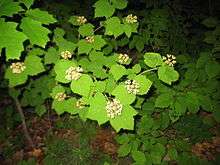Viburnum acerifolium
| Viburnum acerifolium | |
|---|---|
 | |
| Scientific classification | |
| Kingdom: | Plantae |
| (unranked): | Angiosperms |
| (unranked): | Eudicots |
| (unranked): | Asterids |
| Order: | Dipsacales |
| Family: | Adoxaceae |
| Genus: | Viburnum |
| Species: | V. acerifolium |
| Binomial name | |
| Viburnum acerifolium L. | |
 | |
| Natural range in North America | |
Viburnum acerifolium (mapleleaf viburnum or dockmackie) is a species of Viburnum, native to eastern North America from southwestern Quebec and Ontario south to northern Florida and eastern Texas, and it is adapted for USDA hardiness zones of 4 to 8.
It is a shrub growing to 1-2 m (3 to 6 feet) tall. The leaves are in opposite pairs, 5-10 cm (2 to 5") long and broad, three- to five-lobed, the lobes with a serrated margin, and the leaf surface has a fuzzy texture. There is a diverse manifestation of autumn color with this species from pale yellow to bright yellow to orange or pink, rose, or red-purple depending on the light exposure and weather conditions. The flowers are white with five small petals, produced in terminal cymes 4-8 cm (about 3 inches) diameter. The fruit is a small red to purple-black drupe 4-8 mm (about 1/3") long. It attracts butterflies and birds. Viburnum acerifolium is a larval host to the Celastrina ladon butterfly. It grows in and around upland forest, able to do well in full shade and dry soils. It grows mostly in acid soil of pH 5.0 to 6.5, but can tolerate up to 7.5. The shrub often ground suckers some and can form a colony in time.
Landscape architects and designers have often recommended it for shady, dry locations for several decades, but it is only sold at a few very large, diverse nurseries or specialty or native plant nurseries and is not generally well known in the trade or with homeowners. Jenkins Arboretum in southeast Pennsylvania has a very handsome large mass of this shrub in a partial shade location, so it can be a good looking ornamental.
The scientific and common names refer to the superficial similarity of the leaves to those of some maples (Acer); the plant is occasionally mistaken for young maples, but is readily distinguished by the flowers and fruit; the viburnum produces small, purple berries, while maples produce dry, winged seeds.

References
- ↑ "Viburnum acerifolium". NatureServe Explorer. NatureServe. Retrieved 2007-07-06.
- Germplasm Resources Information Network: Viburnum acerifolium
- USDA Plants Profile: Viburnum acerifolium
- Bioimages: Viburnum acerifolium
